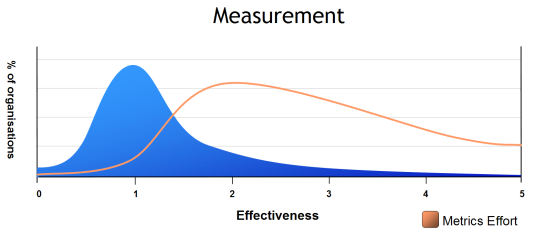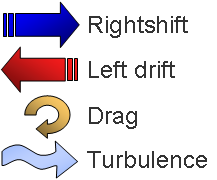Shifting and Drifting – Some Measures
Shifting and Drifting – Some Measures
I’m not a great fan of metrics and measurement, preferring instead to mostly intuit the state of play inside a business, through e.g. MBWA, going to the Gemba, and other ways of just talking with folks to get knowledge. I know some other folks have a different view, so this post is for them.
The above chart shows the amount of effort organisations typically put into their metrics (measurement) programmes, overlaid against the basic Rightshifting (blue) curve.
“It is wrong to suppose that if you can’t measure it, you can’t manage it – a costly myth”
~ WE Deming “The New Economics” 1994 – Ch. 2, page 35
“…management by numerical goal is an attempt to manage without knowledge of what to do, and in fact is usually management by fear.”
~ WE Deming “Out of the Crisis” 1982 – Ch.2, page 76
“the most important figures that one needs for management are unknown or unknowable”
~ WE Deming “Out of the Crisis” 1982 – Ch. 3, page 121
Aside: I’m not suggesting that MBWA is the sole prerogative of managers – I’d suggest that any organisation can benefit from folks of all stripes just wandering around to get knowledge. See also: Lay Off the Managers (blog post).
Following on from my previous blog post “Swimming Against the Tide“, this post provides some ideas to those folks who might wish to measure things in the context of a Rightshifting effort. Note: from the above chart, we can see that highly effective organisations do measure some things, just nowhere near as many things, or with as much effort, as their less effective cousins.
Goal, Question, Metric
Victor Basili et al conceived of a framework for deciding what to measure in software organisations in their work known as “GQM“. The basis of GQM is that (M)etrics should derive from certain (Q)uestions to which we want answers, and those questions, in turn, should concern the (G)oals we’re trying to achieve. In other words:
Goals ➡ Questions ➡ Metrics
GQM for the Rightshifting Organisation
Following the GQM theme, I posit that the goals of an organisation engaged in becoming more effective might include:
- The basic objective of becoming more effective.
- An understanding of the volatility (entropy) of the business’ operating context.
- Scheduling the investments in the drive for more effectiveness.
- Limiting the impact of organisational (internal) changes on customers and other stakeholders.
- How well are we doing in becoming more effective?
- What’s the strength of the change-related “tide” we’re swimming against as a business?
- How much do we have to spend (net, gross) to become more effective (i.e. to move one unit to the right)?
- How much are our efforts disrupting or otherwise impacting our customers and other stakeholders?
- Gross rightshifting velocity (progress to the rights, per unit of time) (Rightshift).
- Velocity of the prevailing Left-drift (the effects of entropy, per unit of time) (Left drift).
- Cost to move one unit (say, 0.1 of a rightshifting index point) to the right (Drag).
- Impact on stakeholders from our rightshifting efforts (Turbulence).
– Bob
Further Reading
Competitive Engineering – Tom Gilb
Software Metrics: A Rigorous and Practical Approach – Fenton and Bieman
Goal/Question/Metric Method: A Practical Guide for Quality Improvement of Software Development – Van Solingen &and Berhout (pricey!)




Bob,
Interesting starting point. I suppose that specific metrics will be highly contextual, so there might be something intermediate needed that’s “not yet numbers”. Not sure what’s missing, thinking of leading/lagging indicators or making explicit the assumptions/filters/biases in our believes about our business and its environment…
A clear vision with measurable requirements might help as well to identify where we stand, yet this might be a hen/egg situation…
We should find an example to elaborate this model.
Thanks for your inspiring writing!
Take care
Olaf
How about first visualizing the intended goals of right shifting?
Can you see evidence of it in the physical plant – (posters, environment, events, meetings reflecting the specific objective).
Can you measure the quality of conversation?
I have read so many books related to this because this is one of my cherished goals – to help just this one thing – quality of conversation. Are people skilled at ‘Advocacy’ and ‘Inquiry’?
How effective are meetings over time (before/after ‘right shifting initiative)? Collect feedback after meetings? Collect stories? Measuring this is hard unless you have someone there to log and record results…
Can you measure change in morale?
Could using ‘Clean Slate’ sessions (sort of like retrospectives, but in the context of Siraj Sirajuddin’s work on the Influencers Mantra and related activities) to uncover trends in overall morale and success.
Hi Andrea,
Thanks for joining the conversation. Rightshifting speaks to the effectiveness of the whole organisation. Each organisation should find its own definition of the term “effectiveness”. What one organisation might regard as highly-effective (for an organisation), another may not. Once an organisation has come to their own definition, it must then decide on the means it supposes will lead to a right-shift.
Some of the means you mention may well (quality of conversations, meetings, use of stories, morale, Clean slate sessions, etc.) may indeed form part of those selected means. Note also; organisations at different stages along the rightshifting spectrum will be constrained to select means congruent with their current mindset and skill level. This is why I subtitle the Marshall Model as “Dreyfus for the Organisation”.
Rightshifting deliberately stands back from the “how”, to generate “negative space” and thereby encourage folks to “think for themselves, in context”. For more on this idea, see: /2010/07/31/transcript-of-email-to-papachrismatts-explaining-rightshifting/
– Bob
Pingback: Five Blogs – 21 May 2012 « 5blogs